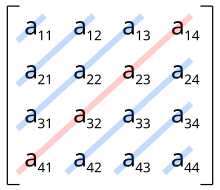Counter diagonal
In mathematics , the counter- diagonal or antidiagonal of a square matrix consists of the matrix elements that lie on an imaginary line running diagonally from top right to bottom left. More generally, the counter- diagonals of a matrix consist of the matrix elements that lie on any diagonal line from top right to bottom left. Occasionally, the opposite diagonals of a matrix are also referred to as "secondary diagonals"; However, the secondary diagonals of a matrix are usually understood to mean the diagonals of the matrix that run parallel to the main diagonal .
The counter diagonals of a matrix are, for example, usually used by Sarrus .
definition
The opposite diagonal of a square matrix
consists of those entries in the matrix that lie on the diagonal from top right to bottom left, i.e. the elements
- .
The opposite diagonal thus consists of those matrix entries whose sum of the row and column index results in the value . In general, the counter-diagonals of a matrix of any size consist of those entries whose sum of row and column index is constant, i.e. for which
with a constant value applies.
example
The opposite diagonal of the real matrix
consists of the elements . The other opposite diagonals of the matrix also have constant entries. Matrices with this property are called Hankel matrices .
use

The opposite diagonal of a matrix is the counterpart to the diagonal of the matrix, which is also referred to as the main diagonal . The opposite diagonals of a matrix are then the counterparts to the diagonals of the matrix, which outside the main diagonals are also referred to as secondary diagonals of the matrix.
In Sarrus' rule , the determinant of a matrix is calculated with the help of the diagonals and counter-diagonals of the matrix extended by the first two columns.
A matrix that is symmetric with respect to its counter-diagonal is called a persymmetric matrix . A Toeplitz matrix is a persymmetrical matrix in which the entries on the main diagonal and the secondary diagonals are constant. A matrix that is symmetrical both with respect to its diagonal and with respect to its counter-diagonal is called a bisymmetrical matrix .
literature
- Roger A. Horn, Charles R. Johnson: Matrix Analysis . Cambridge University Press, 2012, ISBN 978-0-521-83940-2 .
Individual evidence
- ^ Roger A. Horn, Charles Johnson: Matrix analysis . Cambridge University Press, 2013, pp. 33 .
Web links
- Eric W. Weisstein : Skew diagonal . In: MathWorld (English).









